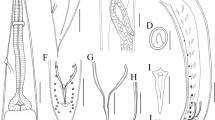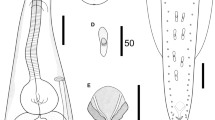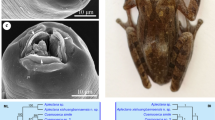Abstract
Species of Cosmocerca Diesing, 1861 (Ascaridomorpha: Cosmocercoidea), are common nematode parasites of amphibians. In the present study, a new species of Cosmocerca, namely C. simile n. sp., was described using light and scanning electron microscopy, and sequencing different nuclear and mitochondrial genetic markers (i.e. small ribosomal DNA (18S), large ribosomal DNA (28S), internal transcribed spacer (ITS) and cytochrome c oxidase subunit 1 (cox1)). Cosmocerca simile n. sp. differs from its congeners based on body size, morphology and number of plectanes, relative length of spicules and gubernaculum and spicules to total body length and morphology and length of tail. Molecular analysis showed no nucleotide polymorphisms among different individuals of the new species regarding nuclear DNA. Very low intraspecific nucleotide variation (0.52–0.78%) was detected in cox1 mtDNA. In contrast, the level of interspecific nucleotide variation between C. simile n. sp. and its congeners were distinctly higher (2.74–18.1% in the partial ITS region and 10.2–13.5% in the partial cox1 region, respectively) than that of intraspecific variation. Phylogenetic analyses using maximum likelihood (ML) inference based on the partial ITS and cox1 sequence data both supported the new species to be a member of the genus Cosmocerca, and formed a sister relationship to C. japonica. The newly obtained genetic data are important for further studies of DNA-based taxonomy, population genetics and phylogenetics of the Cosmocercoidea.




Similar content being viewed by others
References
Baker MR, Green DM (1988) Helminth parasites of native frogs (Leiopelmatidae) from New Zealand. Can J Zool 66:707–713
Baker MR, Vaucher C (1984) Parasitic helminths from Paraguay VI: Cosmocerca Diesing, 1861 (Nematoda: Cosmocercoidea) from frogs. Rev Suisse Zool 91:925–934
Bursey CR, Goldberg SR, Siler CD, Brown RM (2015) A new species of Cosmocerca (Nematoda: Cosmocercidae) and other helminths in Cyrtodactylus gubaot (Squamata: Gekkonidae) from the Philippines. Acta Parasitol 60:675–681
Chabaud AG, Campana-Rouget Y (1955) Helminths de la region de Banyule I. Nematode Parasites d’Amphibians Vie et Milieu 6:83–92
Chen H-X, Zhang L-P, Gibson DI, Lü L, Xu Z, Li H-T, Ju H-D, Li L (2018) Detection of ascaridoid nematode parasites in the important marine food-fish Conger myriaster (Brevoort) (Anguilliformes: Congridae). Parasite Vector 11:274
Falcón-Ordaz J, Windfield-Perez JC, Mendoza-Garfias B, Parra-Olea G, Perez-Ponce De Leon G (2007) Cosmocerca acanthurum n. sp. (Nematoda: Cosmocercidae) in Pseudoeurycea leprosa and Chiropterotriton orculus from the Transmexican Volcani Belt, Central Mexico, with a checklist of the helminth parasites of plethodontid salamanders. Zootaxa 1434:27–49
Floyd RM, Rogers AD, Lambshead PJD, Smith CR (2005) Nematode-specific PCR primers for the 18S small subunit rRNA gene. Mol Ecol Notes 5:611–612
González CE, Hamann MI (2008) Nematode parasites of two anuran species Rhinella schneideri (Bufonidae) and Scinax acuminatus (Hylidae) from Corrientes, Argentina. Rev Biol Trop 56:2147–2161
Kung CC, Wu HW (1945) Parasitic nematodes of amphibians from Pehpei, Szechwan, China. Sinensis 16:73–83
Lazarova SS, Malloch G, Oliveira CM, Hübschen J, Neilson R (2006) Ribosomal and mitochondrial DNA analyses of Xiphinema americanum-group populations. J Nematol 38:404–410
Li L, Liu Y-Y, Zhang L-P (2012) Morphological and genetic characterization of Hysterothylacium zhoushanensis sp. nov. (Ascaridida: Anisakidae) from the flatfish Pseudorhombus oligodon (Bleeker) (Pleuronectiformes: Paralichthyidae) in the East China Sea. Parasitol Res 111:2393–2401
Li L, Du L-Q, Xu Z, Guo Y-N, Wang S-X, Zhang L-P (2014) Morphological variability and molecular characterisation of Dichelyne (Cucullanellus) pleuronectidis (Yamaguti, 1935) (Ascaridida: Cucullanidae) from the flatfish Pleuronichthys cornutus (Temminck & Schlegel) (Pleuronectiformes: Pleuronectidae) in the East China Sea. Syst Parasitol 87:87–98
Li L, Zhao J-Y, Chen H-X, Ju H-D, An M, Xu Z, Zhang L-P (2017) Survey for the presence of ascaridoid larvae in the cinnamon flounder Pseudorhombus cinnamoneus (Temminck & Schlegel) (Pleuronectiformes: Paralichthyidae). Int J Food Microbiol 241:108–116
Moravec F, Baruš V (1990) Some nematode parasites from amphibians and reptiles from Zambua and Uganda. Acta Soc Zool Bohemoslov 54:177–192
Moravec F, Kaiser H (1994) Description of Cosmocerca longispicula sp. nov. (Nematoda: Cosmocercidae), a parasite of a dendrobatid frog from Martinique, French Antilles. Parasitol Res 80:29–32
Moravec F, Sey O (1985) Some nematode parasites of frogs (Rana spp.) from North Viet Nam. Parasitol Hung 18:63–67
Moravec F, Sey O (1990) Some nematode parasites of frogs from Papua New Guinea and Australia. Acta Soc Zool Bohemoslov 54:268–286
Nadler SA, Hudspeth DSS (1998) Ribosomal DNA and phylogeny of the Ascaridoidea (Nemata: Secernentea): implications for morphological evolution and classification. Mol Phylogenet Evol 10:221–236
Rizvi AN, Bursey CR, Bhutia PT (2011) Cosmocerca kalesari sp. nov. (Nematoda, Cosmocercidae) in Euphlyctis cyanophlyctis (Amphibia, Anura) from Kalesar Wildlife Sanctuary, Haryana, India. Acta Parasitol 56:202–207
Rodrigues HO, Fabio SP (1970a) Nova especie do genero Cosmocera Diesing, 1861 (Nematoda, Oxyuroidea). Atas Soc Biol Rio de Janeiro 13:179–180
Rodrigues HO, Fabio SP (1970b) Contribuicao ao estudo do genero Cosmocera Diesing, 1861 (Nematoda, Oxyuroidea). Atas Soc Biol Rio de Janeiro 14:5–6
Sato A, Hasegawa H, Sekiya K, Tsubouchi T (2015) Is Cosmocerca (Nematoda: Cosmocercidae) parasitic in Japanese amphibians a single species? Japn J Vet Parasitol 14:7–12
Skrjabin KI, Shikhobalova NP, Lagodovskaya EA (1961) Oxyurata of animals and man. Part two, Translated from Russian. Israel Program for Scientific Translations, Jerusalem, 1974, pp. 460
Sou SK, Nandi AP (2015) On a new species of Cosmocerca (Nematoda; Cosmocercidae) from Microhyla rubra (Anura: Microhylidae) from West Bengal, India. Acta Parasitol 60:261–265
Sou SK, Sow KK, Nandi AP (2018a) Cosmocerca bengalensis sp. nov. (Nematoda: Cosmocercidae) in Hoplobatrachus tigerinus (Daudin, 1803) (Amphibia, Anura, Dicroglossidae) from West Bengal, India. Acta Parasitol 63:715–720
Sou SK, Sow KK, Nandi AP (2018b) Redescription of Cosmocerca ornata (Dujardin, 1845) Diesing, 1861 (Nematoda: Cosmocercidae) from Ranid frogs of West Bengal. India Proc Zool Soc 72:372–379. https://doi.org/10.1007/s12595-018-0279-6
Yamaguti S (1938) Studies on the helminth fauna of Japan. Part 23. Two new species of amphibian nematodes. Japn J Zool 7:603–607
Zhang K, Xu Z, Chen H-X, Guo N, Li L (2018) Anisakid and raphidascaridid nematodes (Ascaridoidea) infection in the important marine food-fish Lophius litulon (Jordan) (Lophiiformes: Lophiidae). Int J Food Microbiol 284:105–111
Zhao J-Y, Zhao WT, Ali AH, Chen H-X, Li L (2017) Morphological variability, ultrastructure and molecular characterisation of Hysterothylacium reliquens (Norris & Overstreet, 1975) (Nematoda: Raphidascarididae) from the oriental sole Brachirus orientalis (Bloch & Schneider) (Pleuronectiformes: Soleidae). Parasitol Int 66:831–838
Zhao W-T, Xu Z, Li L (2018) Morphological variability and molecular characterization of Mawsonascaris australis (Johnston & Mawson, 1943) (Nematoda: Ascaridoidea: Acanthocheilidae) from the brown guitarfish Rhinobatos schlegelii Müller & Henle (Rhinopristiformes: Rhinobatidae). J Helminthol 92:760–764
Zhu X, D’Amelio S, Paggi L, Gasser RB (2000) Assessing sequence variation in the internal transcribed spacers of ribosomal DNA within and among members of the Contracaecum osculatum complex (Nematoda: Ascaridoidea: Anisakidae). Parasitol Res 86:677–683
Acknowledgements
The authors are grateful to Dr. František Moravec (Institute of Parasitology, Biology Centre of the Czech Academy of Sciences, Czech Republic), professor Hideo Hasegawa (Faculty of Medicine, Oita University, Japan), for providing important literature.
Funding
This study was supported by the National Natural Science Foundation of Hebei Province (C2019205094), the Support Program for 100 Excellent Innovative Talents of Hebei Province (SLRC2019033), the Strategic Priority Research Program of the Chinese Academy of Sciences (XDB26000000) and the Youth Top Talent Support Program of Hebei Province for Dr. Liang Li.
Author information
Authors and Affiliations
Corresponding author
Ethics declarations
Conflict of interest
The authors declare that they have no conflict of interest.
Ethics approval and consent to participate
This study was approved by the Animal Ethics Committee of Hebei Normal University as complying with the Animal protection law of the People’s Republic of China.
Additional information
Section Editor: Hiroshi Sato
Publisher’s note
Springer Nature remains neutral with regard to jurisdictional claims in published maps and institutional affiliations.
Rights and permissions
About this article
Cite this article
Chen, HX., Zhang, LP., Feng, YY. et al. Integrated evidence reveals a new species of Cosmocerca (Ascaridomorpha: Cosmocercoidea) from the Asiatic toad Bufo gargarizans Cantor (Amphibia: Anura). Parasitol Res 119, 1795–1802 (2020). https://doi.org/10.1007/s00436-020-06687-3
Received:
Accepted:
Published:
Issue Date:
DOI: https://doi.org/10.1007/s00436-020-06687-3




